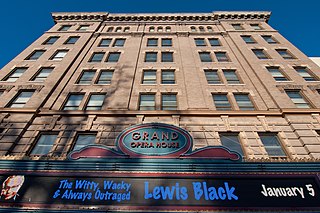
The Grand Opera House, often called The Grand and originally known as the Academy of Music, is a historic opera house located in Macon, Georgia, United States. Listed on the National Register of Historic Places in 1970, it is now the performing arts center of Mercer University.
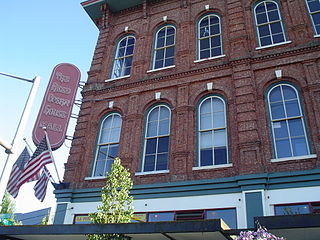
The Reed Opera House and McCornack Block Addition, more commonly known as The Reed Opera House or The Reed, is a historic building in downtown Salem, Oregon, United States. Since its grand opening on September 27, 1870, the Reed Opera House has served as a performing arts center and shopping mall. The Italianate brick structure was added to the National Register of Historic Places in 1978.
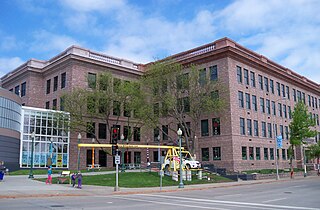
The Washington Pavilion of Arts and Science opened in 1999 and houses an art gallery, concert hall, large-format theater, and science museum in Sioux Falls, South Dakota, United States. Its building, the former Washington High School, is listed on the National Register of Historic Places.

The Paramount Theatre is a concert venue in Denver, Colorado, located on Glenarm Place, near Denver's famous 16th Street Mall. The venue has a seating capacity of 1,870 but is a popular destination for large acts looking for a smaller concert setting. With spelling as Paramount Theater, the building was listed on the National Register of Historic Places in 1980.
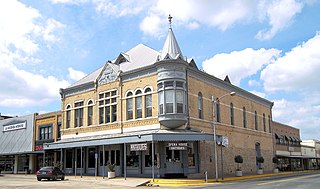
The Grand Opera House, also known as the Janey Slaughter Briscoe Grand Opera House is a historic theater in Uvalde, Texas. Built in 1891, it became a premier arts venue in Southwest Texas for plays, musicals, and cultural performances. The Opera House is the oldest functioning theater in the state of Texas and presents plays and concerts by local and touring companies. It was added to the National Register of Historic Places on May 22, 1978.

The Grand Opera House, also known as the St. James Opera House, is a historic theater building in St. James, Minnesota, United States, completed in 1892. It was listed on the National Register of Historic Places in 2009 for its local significance in the theme of entertainment/recreation. It was nominated for being the city's principal performance venue from 1892 to 1921, bringing fine performing arts like theater, music, and comedy to a modest agricultural center, as well hosting local events. Like many of the hundreds of opera houses built across the Midwestern United States from 1880 to 1910, the St. James opera house contains its auditorium on the upper floor, with retail space on the ground floor as a source of rental income.

The Thomaston Opera House is a historic performance venue and the town hall of Thomaston, Connecticut. Located at 153 Main Street, it was built in 1883-85, and is a good local example of Romanesque architecture. The theater in the building has served as a performance and film venue since its construction. It was listed on the National Register of Historic Places in 1972. The opera house's principal tenant is now the Landmark Community Theatre.

The Kaleva Temple is a commercial building located on Trimountain Avenue in South Range, Michigan. It was listed on the National Register of Historic Places in 1982.

The Alexis Opera House is a historic theater building located at 101–105 N. Main St. in Alexis, Illinois. The building, which operated from 1889 until 1920, hosted traveling entertainment and community functions. It was added to the National Register of Historic Places on July 30, 1987.

Harlan Hall is a historic opera house located at 603 Locust St. in Marshall, Illinois. The opera house opened in 1872 to provide a venue for theatrical performances in Marshall. The building has an Italianate design with tall, narrow windows, wide bracketed eaves, and a steeply sloping roof. Both local and traveling theatrical acts performed in the theater, which also hosted concerts, public meetings, and other events. The opera house had a livery stable on its first floor for its patrons' horses, an unusual feature for contemporary theaters. In 1904, B. F. Johnson purchased the building and converted it to a movie theater; while it still served as a civic auditorium, the building no longer showed theatrical performances after this point. The building has since held a Moose Lodge, and its first floor has been converted to a commercial space.

The Woodsville Opera Building is a historic commercial and performance building at 67 Central Street in Woodsville, New Hampshire, the commercial center of the town of Haverhill. Built in 1890, it is a local architectural landmark, and includes a performance venue that has been used for many local events, including high school graduations and proms. The building was listed on the National Register of Historic Places in 1980.

The Harrington-Smith Block, formerly known as the Strand Theater and the Manchester Opera House, is a historic commercial building at 18-25 Hanover Street in the heart of Manchester, New Hampshire. Built in 1881 to a design by John T. Fanning for two prominent local developers, the building is an expansive rendition of Queen Anne styling in brick and stone. It housed the city's premier performance venue for many years, and was an early home of the influential Manchester Union Leader, the state's major daily newspaper. The building was listed on the National Register of Historic Places in 1987.

The Isaac Reed House is a historic house at 30-34 Main Street in downtown Newport, New Hampshire. Built about 1869, it is a good local example of Second Empire architecture, and an important visual element of the surrounding commercial downtown and civic area. The house was listed on the National Register of Historic Places in 1985, and is a contributing property to the Newport Downtown Historic District.

The Stonington Opera House is a theatrical venue at the corner of Main and School Streets in the center of Stonington, Maine. Built in 1912, it is one of a small number of early 20th-century performance halls constructed in Maine. It is the current home of Opera House Arts, a non-profit organization dedicated to restoring and preserving the historic building to its original purpose as a central community institution. The building was listed on the National Register of Historic Places in 1991.
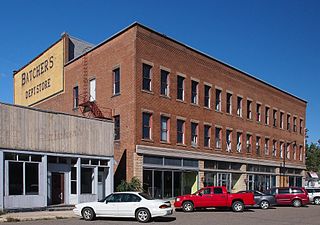
The Batcher Opera House Block is a historic 1907 building located in downtown Staples, Minnesota, United States. It contained commercial business on the first floor and an opera house on the 2nd floor. The opera house was an entertainment venue that featured live theater productions from 1907 until the 1920s. It was placed on the National Register of Historic Places in 2004.

The Hayford Block is a historic commercial building at 47 Church Street in downtown Belfast, Maine. Built in 1866 and enlarged in 1869, it was the first significant construction after a major fire devastated central Belfast in 1865. It is also home to Hayford Hall, an opera house that was for many years the city's major performance venue.
The Corning Opera House is a theater located in Corning, Iowa, United States. This was the third of three opera houses built in town. The other two were built in the 1880s, and this one was completed in 1902. It was the only opera house in Corning by 1907, and it served as a theater until 1934. From its opening in 1902 until 1921 it staged theatrical performances, and from about 1920 to 1931 it showed movies. It also staged vaudeville performances and high school productions. The theater was located on the second floor. It features the original raked stage, seating on the main floor and the original horseshoe-shaped balcony, and it has a small stage and backstage offers a make up room and 2 green rooms. Historically, Commercial space was located on the main floor of the building, now the first floor features a conference room for renting and a commercial kitchen.

The Galva Opera House is a historic theater located at 334-348 Front Street in Galva, Illinois. Built in 1878, the theater opened as the Blue Ribbon Temperance Hall; by 1886, it had lost its association with the temperance movement and was known by its present name. Galva's location on two major railroad lines allowed traveling theatrical troupes to visit the theater; shows produced by local talent performed in the building as well. Local schools also used the building for their graduation ceremonies, sporting events, and school plays until Galva High School opened its own auditorium in 1932. The building was used as a roller skating rink in the 1920s and 1930s and hosted Lions Club events in the 1950s.
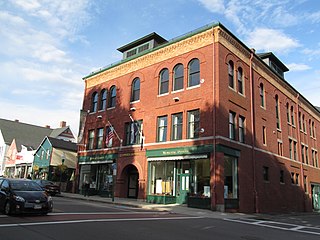
The Camden Opera House Block is a historic multifunction building at 29 Elm Street in the center of Camden, Maine, United States. Built in 1893 after the town's great 1892 fire, it is one of its most prominent buildings. It houses town offices, a social meeting hall, and a 500-seat theater. The building was listed on the National Register of Historic Places in 1986.
The E.J. Bullock Block is a historic commercial building at 7012 Main Street in Readsboro, Vermont. Built in 1891, it is a prominent local example of Second Empire architecture, with a long history of commercial, social, and civic uses. The building was listed on the National Register of Historic Places in 2021.




















